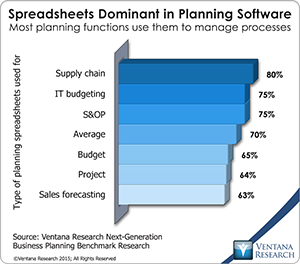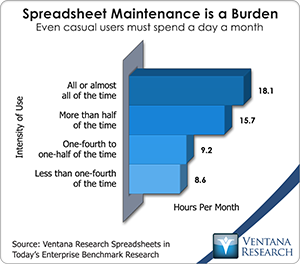In our benchmark research at least half of participants that use spreadsheets to support a business process routinely say that these tools make it difficult for them to do their job. Yet spreadsheets continue to dominate in a range of business functions and processes. For example, our recent next-generation business planning research finds that this is the most common software used for performing 11 of the most common types of planning. At the heart of the problem is a disconnect between what spreadsheets  were originally designed to do and how they are actually used today in corporations. Desktop spreadsheets were intended to be a personal productivity tool used, for example, for prototyping models, creating ad hoc reports and performing one-off analyses using simple models and storing small amounts of data. They were not built for collaborative, repetitive enterprise-wide tasks, and this is the root cause of most of the issues that organizations encounter when they use them in such business processes. Software vendors and IT departments have been trying – mainly in vain – to get users to switch from spreadsheets to a variety of dedicated applications. They’ve failed to make much of a dent because, although these applications have substantial advantages over spreadsheets when used in repetitive collaborative enterprise tasks, these advantages are mainly realized after the model, process or report is put to use in the “production” phase (to borrow an IT term). To date most dedicated applications have been far more difficult than spreadsheets for the average business user to use in the design and test phases. To convince people to switch to their dedicated application, a vendor must offer an alternative that lets users model, create reports, collect data and create dedicated data stores as easily as they can do it in a desktop spreadsheet. Spreadsheets are seductive for most business users because, even with a minimum amount of training and experience, it’s possible to create a useful model, do analysis and create reports. Individuals can immediately translate what they know about their business or how to present their ideas into a form and format that makes sense to them. They can update and modify it whenever they wish, and the change will occur instantly. For these business users ease of use and control trump putting up with the issues that routinely occur when spreadsheets are used in collaborative enterprise processes. Moreover, it’s hard to persuade “spreadsheet jockeys” who have strong command of spreadsheet features and functions that they should start over and learn how to use a new application. Those who have spent their careers working with spreadsheets often find it difficult to work with formal applications because those applications work in ways that aren’t intuitive. Personally these diehards may resist because not having control over analyses and data would diminish their standing in the organization. Nevertheless, there are compelling reasons for vendors to keep trying to devise dedicated software that an average
were originally designed to do and how they are actually used today in corporations. Desktop spreadsheets were intended to be a personal productivity tool used, for example, for prototyping models, creating ad hoc reports and performing one-off analyses using simple models and storing small amounts of data. They were not built for collaborative, repetitive enterprise-wide tasks, and this is the root cause of most of the issues that organizations encounter when they use them in such business processes. Software vendors and IT departments have been trying – mainly in vain – to get users to switch from spreadsheets to a variety of dedicated applications. They’ve failed to make much of a dent because, although these applications have substantial advantages over spreadsheets when used in repetitive collaborative enterprise tasks, these advantages are mainly realized after the model, process or report is put to use in the “production” phase (to borrow an IT term). To date most dedicated applications have been far more difficult than spreadsheets for the average business user to use in the design and test phases. To convince people to switch to their dedicated application, a vendor must offer an alternative that lets users model, create reports, collect data and create dedicated data stores as easily as they can do it in a desktop spreadsheet. Spreadsheets are seductive for most business users because, even with a minimum amount of training and experience, it’s possible to create a useful model, do analysis and create reports. Individuals can immediately translate what they know about their business or how to present their ideas into a form and format that makes sense to them. They can update and modify it whenever they wish, and the change will occur instantly. For these business users ease of use and control trump putting up with the issues that routinely occur when spreadsheets are used in collaborative enterprise processes. Moreover, it’s hard to persuade “spreadsheet jockeys” who have strong command of spreadsheet features and functions that they should start over and learn how to use a new application. Those who have spent their careers working with spreadsheets often find it difficult to work with formal applications because those applications work in ways that aren’t intuitive. Personally these diehards may resist because not having control over analyses and data would diminish their standing in the organization. Nevertheless, there are compelling reasons for vendors to keep trying to devise dedicated software that an average  business user would find as easy and intuitive as a desktop spreadsheet in the design, test and update phases. Such an application would eliminate the single most important obstacle that keeps organizations from switching. The disadvantages of using spreadsheets are clear and measurable. One of the most significant is that spreadsheets can waste large amounts of time when used inappropriately. After more than a few people become involved and a file is used and reused, issues begin to mount such as errors in data or formulas, broken links and inconsistencies. Changes to even moderately complex models are time-consuming. Soon, much of the time spent with the file is devoted to finding the sources of errors and discrepancies and fixing the mistakes. Our research confirms this. When it comes to important spreadsheets that people use over and over again to collaborate with colleagues, on average people spend about 12 hours per month consolidating, modifying and correcting the spreadsheets. That’s about a day and a half per month – or five to 10 percent of their time – just maintaining these spreadsheets. Business applications vendors started to address business users’ reluctance to use their software more than a decade ago when they began to use Microsoft Excel as the user interface (UI). This provides a familiar environment for those who mainly need to enter data or want to do some “sandbox” modeling and analysis. Since the software behind the UI is a program that uses some sort of database, companies avoid the issues that almost arise when spreadsheets are used in enterprise applications. There also are products that address some of the inherent issues with such as the difficulty of consolidating data from multiple individual spreadsheets as well as keeping data consistent. Visualization software, a relatively new category, greatly simplifies the process of collecting data from one or more enterprise data sources and creating reports and dashboards. As the enterprise software applications business evolves to meet the needs of a new generation of users, as I mentioned recently, it’s imperative that vendors find a way to provide users with software that is a real alternative to desktop spreadsheets. By this I mean enterprise software that provides business users with the same ability to model, create reports and work with data the way they do in a desktop spreadsheet as well as update and modify these by themselves without any IT resources. At the same time, this software has to eliminate all of the problems that are inevitable when spreadsheets are used. Only at that point will a dedicated application become a real alternative to using a spreadsheet for a key business process. Regards, Robert Kugel – SVP Research
business user would find as easy and intuitive as a desktop spreadsheet in the design, test and update phases. Such an application would eliminate the single most important obstacle that keeps organizations from switching. The disadvantages of using spreadsheets are clear and measurable. One of the most significant is that spreadsheets can waste large amounts of time when used inappropriately. After more than a few people become involved and a file is used and reused, issues begin to mount such as errors in data or formulas, broken links and inconsistencies. Changes to even moderately complex models are time-consuming. Soon, much of the time spent with the file is devoted to finding the sources of errors and discrepancies and fixing the mistakes. Our research confirms this. When it comes to important spreadsheets that people use over and over again to collaborate with colleagues, on average people spend about 12 hours per month consolidating, modifying and correcting the spreadsheets. That’s about a day and a half per month – or five to 10 percent of their time – just maintaining these spreadsheets. Business applications vendors started to address business users’ reluctance to use their software more than a decade ago when they began to use Microsoft Excel as the user interface (UI). This provides a familiar environment for those who mainly need to enter data or want to do some “sandbox” modeling and analysis. Since the software behind the UI is a program that uses some sort of database, companies avoid the issues that almost arise when spreadsheets are used in enterprise applications. There also are products that address some of the inherent issues with such as the difficulty of consolidating data from multiple individual spreadsheets as well as keeping data consistent. Visualization software, a relatively new category, greatly simplifies the process of collecting data from one or more enterprise data sources and creating reports and dashboards. As the enterprise software applications business evolves to meet the needs of a new generation of users, as I mentioned recently, it’s imperative that vendors find a way to provide users with software that is a real alternative to desktop spreadsheets. By this I mean enterprise software that provides business users with the same ability to model, create reports and work with data the way they do in a desktop spreadsheet as well as update and modify these by themselves without any IT resources. At the same time, this software has to eliminate all of the problems that are inevitable when spreadsheets are used. Only at that point will a dedicated application become a real alternative to using a spreadsheet for a key business process. Regards, Robert Kugel – SVP Research













